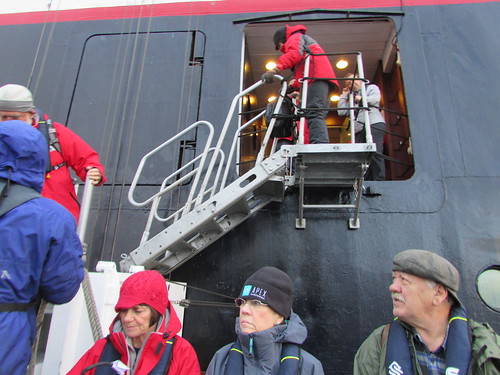In the previous post in this series Visiting Steeple Jason Island, I described our marvellous morning studying penguins and the Black-browed Albatross rookery on Steeple Jason Island. Now read on ...
Once our Zodiacs had returned us to ‘Silver Explorer’ and the hydraulic cranes had been used to stow the Zodiacs onboard, the Captain raised anchor and moved the ship around 30 miles (as the crow flies) south-east to anchor off West Point Island. This island is privately owned but the elderly owner now lives in Stanley. A couple who have sailed around the world on their own boat (moored in the bay awaiting their next expedition) are currently caretakers of what is now a conservation zone.
The ship sent a ‘scout’ Zodiac to the small, stone jetty to make final arrangements with the lady caretaker and, before 3.30 p.m., the passengers had started to be ferried ashore. We were offered a hike across moorland to a clifftop called the Devil’s Nose where there were colonies of Black-browed Albatross alongside Rockhopper penguins. The walk, we were assured, was 1.2 miles but two Land Rovers were available to provide a shuttle service for those who preferred to ride.
I chose to walk but it seemed a particularly long 1.2 miles (and a number of other elderly passengers confirmed my impression). The weather was dry and quite mild when we set off and the trek was very enjoyable, watching the bird life and getting the ‘lie of the land’ but I was quite tired on arrival at the cliff top. The steep way down the cliffs to the various nesting sites was through tall Tussock Grass and I’d experienced that morning the difficulties of moving safely through this dense vegetation. There was also some confusion regarding the exact location of the sites and the best access routes so a number of passengers decided to abandon the attempt. I learned afterwards that a few people suffered slight sprains or immersion knee-deep in mud. By this time, it had also started to rain fairly heavily so, with some reluctance, I decided not to proceed further but to take the next Land Rover shuttle back to the landing point.
Near the landing point, there was a very English-looking cottage reached through a fenced garden where we had been invited to take tea with the lady caretaker.
 The farmhouse on West Point Island where we took afternoon tea.
The farmhouse on West Point Island where we took afternoon tea.
In addition to providing welcome tea or coffee, the large table was covered with cakes, biscuits and various fancies, all home made. The lady was from Sweden, where there is a tradition, apparently, of providing at least seven different snacks. A Swedish lady passenger found out that they both used the same traditional cookery book! This provided an enjoyable interlude, after which we were invited to explore the gardens. Despite the continuing rain, it was fun to discover the various interconnected plots – formal, wild and vegetable gardens. Around six o’clock, thoroughly exhausted by the exertions of both the morning and afternoon landings, I returned to the ship by Zodiac.
 Home-made cakes on West Point Island.
Home-made cakes on West Point Island.
At 7.15 p.m., there was a briefing in the Theatre regarding the plans for the following day which we were to spend in the capital of the Falkland Islands, Stanley. This was followed by a dinner in the Restaurant on Deck 4. All-in-all, a very educational, if tiring, day.
Related posts
Next South Atlantic post.
All my posts on this trip can be found here.
My pictures
You can find all my pictures on the trip in the Collection Cape to Cape (still being added to, at the time of writing).
There are a few pictures of the trip in the album South Atlantic Voyage.
['Cape to Cape' collection added 5-Apr-2016]



